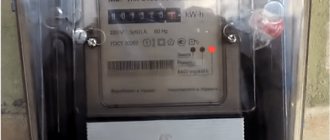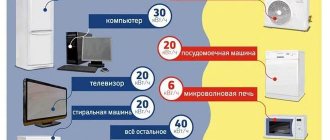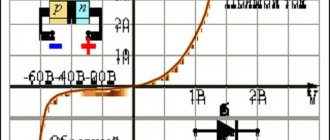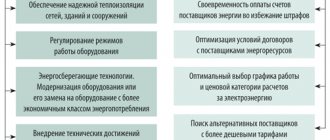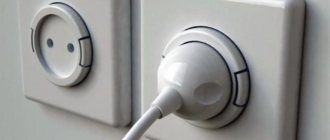What does ODN mean for electricity?
Electricity costs for general house needs (GDE) consist of several factors. This includes lighting of the local area, staircase landings, maintenance of elevator facilities, etc. All this adds up to considerable costs for MKD.
What are the standards for electricity consumption at the ODN used for settlements with the energy supply company? The fair redistribution of electricity costs between apartment owners depends on how the charging system is structured.
Previously, management companies (MCs) of apartment buildings paid for ODN with funds accumulated by subtracting amounts from utility payments of homeowners. It was practically impossible to control the correctness of the accrual of one-time income tax to each owner. Unscrupulous administrators of the management organization took advantage of this, committing fraud with funds.
Starting in 2022, new ODN standards for electricity were introduced. They were determined by calculation, which is closest to the actual electricity consumption for general household needs.
The articles of the new Federal Law (Federal Law) remove from circulation fraudulent schemes that were used to unjustifiably increase the costs of one-way electricity supply, in contrast to the real ones. Cash withdrawals were made from payments made by residents not only in the city, but also in large populated areas throughout the Russian Federation. Innovations forced management administrations to take into account strict rules for accounting, monitoring and saving electricity.
Established calculation rules.
As is known, in the absence of installed and put into operation common house metering devices, the amount of electrical energy to be paid for common house needs is determined by the calculation method - using consumption standards.
The procedure for establishing standards for the consumption of utility services (cold and hot water supply, sewerage, electricity supply, gas supply, heating) and the requirements for their formation are provided for in the Rules for establishing and determining consumption standards[1].
Based on clause 37 of Appendix 1 to these rules, the value of the standard for the consumption of electrical energy for the purpose of maintaining common property in an apartment building (kWh per month per 1 sq. m of the total area of the premises included in the common property in the house) is determined by formula 34:
| W= | ∑ Wtot. i __________ 12 x Soi | , Where: |
Wtotal i is the total annual consumption of electrical energy (kWh) by the i-th group of equipment included in the common property in the apartment building;
Soi – total area of premises included in the common property in the apartment building (sq. m);
12 is the number of months in a year.
How the total area of premises included in the common property in an apartment building should be determined is not indicated in the comments to formula 34 (unlike, for example, formula 26, which calculates utility consumption standards for cold and hot water supply, as well as consumption standards hot water for general house needs).
In formula 26, the total area of the premises included in the common property in the apartment building is defined as the total area of the following premises that are not parts of the apartments of the house and are intended to serve more than one room in the apartment building (according to the information specified in the passport of the house): inter-apartment landings, staircases, corridors, vestibules, halls, lobbies, wheelchairs, security (concierge) premises that do not belong to individual owners.
What is included in the ODN
What is commercial electricity metering
The structure of ODN includes all electricity costs, except for residential consumption:
- electric lighting of stairs, platforms, access vestibules and common corridors;
- light in basements and attics;
- power supply for elevator facilities;
- connection and operation of video cameras and intercoms;
- maintenance of fire alarms, pumps and other electrical equipment for public use;
- losses in household networks.
Network losses
Electricity losses in networks are considered to be the difference between the incoming volume of electric current and its recorded consumption inside the house. Losses are borne by additional payment to the electricity distribution company. Reasons causing intra-house current leakage:
- Incorrect selection of wire cross-sections causes thermal losses of electricity in the electrical wiring conductors.
- Poorly assembled contact groups of switches, lamp sockets, switches, sockets, etc.
- Operation of old electrical equipment.
Losses in networks can be reduced only by replacing old electrical wiring with new wires, the cross-section of which corresponds to the load, as well as by replacing worn-out electrical equipment with more modern devices.
Taking readings from the electric meter
Payment for one day
Electricity consumption standards per person without a meter
In addition to making payments for consumed electricity according to the readings of individual electricity meters, residents of apartment buildings bear the cost of electricity consumption. A special line ODN is included in receipt books for utility services for homeowners.
Payment for consumed electricity according to ODN for one apartment in a multi-storey building is determined by the formula:
Pi=Viodn NS,
Where:
- Viodn – the share of ODNE per apartment.
- N – standard (kWh/1m2), approved by local authorities;
- S – total area of the apartment.
Over the past few years, homeowners of some apartment buildings have begun to notice an unreasonable increase in the amount of payments for electricity bills. This is due to the fact that between the direct consumer and the supplier of electric current there is an intermediary - the management company (MC) of the MKD.
How to take readings
It is necessary to take readings from communal electricity meters every month on the same date.
The management company is responsible for recording meter readings in the presence of the chairman of the council of residents of an apartment building or his deputies.
The utility company may, at its discretion, require meter readings to be reconciled at any time. Homeowners are prohibited from preventing representatives of the management company and energy supply organization from accessing general electricity metering devices.
You may also be interested in the article about benefits for electricity payments. Read an article on how to pay for electricity online here.
After reading this article, you will receive information on how to take electricity meter readings.
Standards for ODN for electricity in the regions of the Russian Federation
Introduction to peak and other electricity tariff zones
The size of the standard depends on the quality of the electrical equipment of the house and its number of floors. Standards in each region of Russia are set by local authorities. They represent a single value per 1 m2 of area, relating to communal premises and local areas.
The new rules for calculating ODNE practically exclude unauthorized increases in the amount of payment for this expense item. Previously, the management company itself made payments to the energy supply company, but now the costs of ODNE are borne by the apartment owners according to a special line in the receipt. The calculation of this expense item is based on the standard adopted by the regional state administration.
There is no uniform standard for ODNE for MKD across the country. In different territorial entities of the Russian Federation, indicators vary greatly. To calculate ODN, you need to take into account a number of factors:
- number of floors of apartment buildings;
- the presence or absence of an elevator, house electric boiler, pumps, lighting of the local area, etc.;
- whether ODPU (common house metering devices) is installed or not;
- local tariff for ODNE.
Based on these data, a standard is formed, on the basis of which LTNE is calculated in the receipt. Since the beginning of 2019, people have been paying for electricity supply according to regional standards. Now, if electricity consumption is less than the standard, then payment is made based on consumption. Below is a table of standards in some regions and republics of Russia, established by local authorities from 01.01. 2022
Table of standards for ODNE
| Regions | Standard ODN, kW/h per 1 m2 per month | |
| MKD without elevator | MKD with elevator | |
| Moskovskaya (Moscow) | 2,88 | 0,61 |
| Leningradskaya (St. Petersburg) | 1,66 | 0,42 |
| Nizhny Novgorod (Nizhny Novgorod) | 1,6 | 0,39 |
| Sverdlovskaya (Ekaterinburg) | 4,16 | 1,96 |
| Saratovskaya (Saratov) | 2,44 | 1,82 |
| Novosibirsk (Novosibirsk) | 0,973 | 0,728 |
| Lipetskaya | 1,24 | 0,37 |
| Rostovskaya (Rostov-on-Don) | 2,24 | 0,55 |
| Yaroslavskaya (Yaroslavl) | 1,01 | 0,646 |
| Republic of Crimea (Simferopol) | 0,58 | 0,21 |
| Krasnodar region (Krasnodar) | 1,412 | 0,322 |
| Republic of Bashkorstan (Ufa) | 0,791 | 0,295 |
| Republic of Adygea (Maykop) | 1,357 | 0,315 |
How to calculate ODNE in MKD using a meter
Homeowners in apartment buildings are often interested in how to calculate the ODN on their own. The calculation is simple. The total area of the apartment building, including communal areas and apartments, is taken as a basis. The established tariff of a specific region is entered into the calculation. The readings of the ODPU and individual electricity meters are taken into account.
If there is no communal meter in the apartment building, then the calculation is carried out according to another option. Below are examples of calculations of ODN for electricity.
Example of calculating ODN
Examples of calculating the ODN of a multi-storey building
There are two formulas for calculating how to pay for one electricity supply. One of them is an option for calculating ODN without a common house electricity meter.
Without counter
Calculate the amount of energy spent on one unit without a meter using the formula:
Viodn = N one x Soi (Si/Sob),
Where:
- N one – consumption rate established by local authorities;
- Soi – communal area;
- Si – apartment area;
- Sob – the entire area of the house.
The management company, which has calculated the amount of energy, multiplies it by the tariff.
With counter
The second formula for calculating ODN for electricity is based on the readings of a common house electricity meter:
Vi = (V d – V tender – V core b – V core – V cr),
Where:
- V d – readings of the common house meter;
- V nezh – electricity consumption in communal premises;
- V lived b – consumption in apartments without an electric meter:
- V lived - the same with the counter;
- V cr – electricity consumption for additional services.
Important! Whether it is necessary to install a common house electricity meter will be shown by a comparative analysis of the costs of one electricity meter if it is present or not. The result will always be in favor of installing a common house meter.
Testimony must be submitted on time
Rules for installing a common house electricity meter
The procedure for installing metering devices is regulated by Order of the Ministry of Energy of the Russian Federation dated 04/07/2010 No. 149 “On approval of the procedure for concluding and essential terms of the agreement governing the conditions for the installation, replacement and (or) operation of metering devices for energy resources used.”
After July 1, 2013, the obligation of the RSO to install a common house meter remains in force. According to the order, in order to organize the installation of a common house electricity meter, the management company or owners send a written application to the RSO. The following documents are attached to the application:
- Copies of documents confirming ownership;
- Copies of constituent documents;
- A copy of the state registration certificate;
- A copy of the certificate of registration with the tax authorities of the Russian Federation;
- Documents confirming the authority of the person signing the application.
Within ten days after receiving the application and documents, the RSO inspects the facility and no later than fifteen days after the inspection sends a draft contract. Having received the contract, the customer signs it fifteen days in advance and sends it back to RSO.
Refusal or evasion of a resource supplying organization from installing a common house electricity meter is a reason to bring to administrative responsibility (Clause 12, Article 9.16 of the Code of Administrative Offenses).
If the volume of one is negative
A negative value of one tax for electricity is added up if the general building meter records the consumed volume of electricity less than the summed readings of apartment meters. This is due to the lack of electricity meters for several homeowners who pay ODNE according to the standard.
The electricity supply company compensates for the negative balance by recalculation, based on the number of residents or the total area of each apartment. This system for calculating ODN for electricity is approved by Article No. 354 of the Government Decree.
Example of calculating a negative balance
Over the course of a month, the difference between the data from ODPU and all MKD electricity meters was 150 kW/hour. The number of residents is 200 people. The difference is distributed per 1 person: 150/200 = 0.75 kW/h. The result obtained is multiplied by the number of residents of each apartment. If 3 people live in it, and the current electricity consumption is 150 kW/h, then 150 will be counted: (0.75 x 3) = 147.75 kW/h.
Law on communal electricity meters
Federal Law No. 261 on November 23, 2009 obligated property owners to independently install communal metering devices. If the meter was not installed before July 1, 2013, resource supply organizations do this, and the owners pay for the device and installation.
Until July 1, 2013 <...> the organizations specified in part 9 of this article are required to take steps to equip them with metering devices for the energy resources used, <...>.
A person <...> must provide access to the specified organizations to the installation sites for metering devices used for energy resources and pay the costs of the specified organizations for the installation of these metering devices. 261-FZ, Art. 12, part 13
You cannot refuse to install a meter. This is done only by objects that consume less than five kilowatts. The cost of installation is calculated in proportion to the area of the apartment or non-residential premises. When the tenant is unable to pay for the installation, the state gives an installment plan for five years, which can be repaid early.
What to do if there is no meter
In the absence of a general electricity meter in the apartment building, the calculation of ODN is carried out in accordance with the approved new standards. The calculation formula looks like this:
Vodn = Nodn xSoi x (Sq/Sob),
Where:
- Vodn – electricity consumption in the apartment;
- Nodn – standard for 1 m2 of MKD area;
- Soi – common house area;
- Sq – apartment area;
- Sob – the sum of the areas of all apartments.
Having determined the share of ODN of each home owner, the management administration adds it to the data of the electric meter, if there is one. When there is no device, the share is added to the standard, which is reflected in a separate line of the ODN receipt.
Which is more profitable: with or without a meter?
Practice shows that significant savings in energy costs come from installing electric meters. Calculations without a meter include a large reserve of excess electricity consumption.
If the apartment does not have a meter, then the owner of the apartment building needs to contact the energy supply company, for which a corresponding agreement is concluded. The owner of the apartment can purchase an electric meter himself or use the services of an electricity supplier.
The purchased model of the metering device must be certified by the manufacturer, which is confirmed by the accompanying documentation - the product passport. After contacting the management company with an application to install an electric current consumption meter, a decision is made to call an electrician.
Before installation, the debt for payment for electricity is paid off. The new meter has zero readings. If there is any data on the display, this is noted in a special document.
Installation Rules
There are several options for installing communal meters:
- Residents of an apartment building convene a general meeting of owners and decide on the need for meters at home, and voluntarily raise funds for their purchase and installation.
This usually happens in houses with an active Council of Apartment Owners, as well as when responsible and economically educated people live there, who understand that it will be much more profitable to pay for electricity with working metering meters for common household needs.Funds are withdrawn from the house account under the item “Current repairs”. If there are insufficient funds under this article, the Council makes a decision to collect funds from residents. If the majority of people living in the house agree with the voluntary collection of money, then those who were against this decision will also have to donate money.
- With an underdeveloped council of residents, the management company itself makes decisions on the acquisition and installation of ODN consumption meters. Money for installing meters is partially taken from the “Current repairs” article, and the company offers to collect the missing part from apartment owners and residents, or install energy consumption meters in installments.
- If the management company and homeowners have not come to an agreement on the installation of public meters, then the resource supplying organization is obliged to develop rules for the installation of public energy meters.
The energy supplying organization sends a letter to the management company, which indicates the recommended type of energy meters and carries out the installation itself. Homeowners do not have the right to obstruct access to basements and power supply networks. Payment for electricity meters also falls on the shoulders of the apartment owners of the building and can be made in installments for a period of up to 5 years. Only interest is added to the total cost, which is regulated by the Central Bank of the Russian Federation.
You may be interested in an article about how to pay for electricity using a meter.
Pin Up Casino has long established itself as a major gaming resource where you can get big winnings. For fair play and high returns on licensed slots, gamblers prefer the mobile version of pin-up casinos. The only thing that prevents users from enjoying the game is the frequent blocking of the official website due to the lack of laws that would regulate online casinos. For this reason, Pin Up developers are creating new, up-to-date mirrors. They are no different from the official website. Gamblers have access to the same options and gaming slots as in the Pin Up casino. Through the mirror you can not only play, but also register. Read an article on how you can check your electric meter at home here.
If residents of an apartment building categorically refuse to install communal electricity meters, the Administrative Code provides for fines and penalties for the management company, the HOA, or the energy supply organization.
Refusal by homeowners to pay for energy meters and the current costs of their maintenance threatens to file a lawsuit in Court. And if the owner loses the claim (and this is what happens in most cases), then in addition to the claim, the residents will also have to pay legal costs.
Who can change the meter on the landing from 2022
In apartment buildings, apartment electricity meters are placed in panel cabinets on staircase landings. Over time, electricity meters may break down. Such a meter is replaced by an electrician from the management administration. The specialist has the rights to inspect, install and repair electrical control equipment.
The owner of the home, having noticed a breakdown of the meter or a damaged seal, is obliged to urgently inform the management company about this. The master of this organization will dismantle the old device, install a new electric meter and seal it.
The electrician must be certified and have permission to carry out repair work on electrical equipment of the MKD. This is evidenced by the fact that the electrician has the appropriate certificate.
Note! If the meter is considered an appliance for individual use, then all costs for restoring the power supply to the apartment are borne by its owner. If the housing is listed as municipal property, then the replacement of the electric meter is carried out at the expense of the municipality.
How to reduce the value of ODN for electricity
The lion's share of electricity costs for one-room lighting is made up of electricity spent on lighting in entrances and adjacent areas. Then follow in descending order the energy costs of operating hot water supply and heating pumps, and the functioning of the elevator facilities. A small share of electric current costs is occupied by connecting electrical equipment during repairs in non-residential premises of apartment buildings.
The desire of homeowners in an apartment building to reduce the cost of electricity distribution systems is understandable. Here are some tips on how to reduce them:
- Residents need to be proactive in preventing the lighting of the local area from being turned on during daylight hours.
- Turn off lights on staircases when not necessary.
- In order not to constantly control the switching on of lighting devices in the absence of people, it is necessary to install motion sensors.
- Residents need to know about unauthorized connections to the power grid by tenants of non-residential premises in apartment buildings. If such facts are confirmed, then it is necessary to oblige tenants to bear the costs of one-way electricity supply.
- Apartment owners do not have to delay submitting reports based on electricity meter readings. If payment terms are delayed, the management administration may transfer the owners of such apartments to standard payments.
How to reduce costs for ODNE
Additional Information. The installation of motion sensors in non-residential premises of apartment buildings in Germany became widespread back in the 90s of the last century. This gave a significant saving in electricity costs for apartment owners. Today, this method of saving ODNE in Russia is becoming very popular.
Household electricity meters - legality of installation.
Questions have become more frequent regarding the reasons for management organizations to install communal meters for electricity consumed by an apartment building. This issue is being raised due to an increase in electricity bills, which are spent mainly on lighting common areas in an apartment building. It is for this reason that we provide clarifications to citizens on this issue and think that such clarifications should become a good tradition of our company.
The Housing Code of the Russian Federation, entered into force on March 1, 2005, in part 3 of Article 39 provides that the rules for maintaining common property in an apartment building are established by the Government of the Russian Federation.
In pursuance of the requirements of the federal legislator, Decree of the Government of the Russian Federation of August 13, 2006 N 491 approved the Rules for the maintenance of common property in an apartment building.
According to the Rules, the composition of common property includes:
a) premises in an apartment building that are not parts of apartments and are intended to serve more than one residential and (or) non-residential premises in this apartment building (hereinafter referred to as common areas), including inter-apartment landings, stairs, elevators, elevators and others shafts, corridors, strollers, attics, technical floors (including built-in garages and areas for vehicles, workshops, technical attics built at the expense of the owners of the premises) and technical basements in which there are utilities, otherwise serving more than one residential and (or) non-residential premises in an apartment building equipment (including boiler rooms, boiler rooms, elevator units and other engineering equipment);
b) roofs;
c) enclosing load-bearing structures of an apartment building (including foundations, load-bearing walls, floor slabs, balcony and other slabs, load-bearing columns and other enclosing load-bearing structures);
d) enclosing non-load-bearing structures of an apartment building serving more than one residential and (or) non-residential premises (including windows and doors of common areas, railings, parapets and other enclosing non-load-bearing structures);
e) mechanical, electrical, sanitary and other equipment located in an apartment building outside or inside the premises and serving more than one residential and (or) non-residential premises (apartment);
f) a land plot on which an apartment building is located and the boundaries of which are determined on the basis of state cadastral registration data, with elements of landscaping and landscaping;
g) other facilities intended for the maintenance, operation and improvement of an apartment building, including transformer substations, heating points intended to serve one apartment building, collective parking lots, garages, children's and sports grounds located within the boundaries of the land plot on which the apartment building is located .
This regulatory legal act was published in the Collection of Legislation of the Russian Federation No. 34, August 21, 2006, “Rossiyskaya Gazeta” dated August 22, 2006.
The rules regulate relations regarding the maintenance of common property owned by the right of common shared ownership to the owners of premises in an apartment building, including indicating the requirements for the maintenance of such property, in particular: ensuring the constant readiness of utilities, metering devices and other equipment included in the common property, for the provision of utilities (supply of utility resources) to citizens living in an apartment building, in accordance with the Rules for the provision of utility services to citizens.
To ensure favorable and safe living conditions for citizens, proper maintenance of common property in an apartment building, resolving issues regarding the use of said property, as well as providing utilities to citizens living in an apartment building, the Housing Code of the Russian Federation provides for holding a general meeting of owners of premises in such a building, which chooses the method of managing an apartment building (clause 4 of part 2 of Article 33).
According to Part 2 of Article 161 of the Housing Code of the Russian Federation, owners of premises in an apartment building choose one of the methods of managing an apartment building: 1) direct management of the owners of premises in an apartment building; 2) management of a homeowners’ association or a housing cooperative or other specialized consumer cooperative; 3) management of the management organization.
Thus, managing a management organization is one of the ways to manage an apartment building.
According to part 7 of Art. 155 of the Housing Code of the Russian Federation, owners of premises in an apartment building in which a homeowners’ association or a housing cooperative or other specialized consumer cooperative has not been created and which is managed by a management organization, pay fees for residential premises and utilities to this management organization.
According to Part 1 of Art. 157 Housing Code of the Russian Federation
the amount of payment for utility services is calculated based on the volume of consumed utility services, determined by the readings of metering devices, and in their absence, based on the standards for the consumption of utility services approved by government bodies of the constituent entities of the Russian Federation in the manner established by the Government of the Russian Federation.
The Housing Code of the Russian Federation provides that owners of premises in an apartment building bear the burden of expenses for maintaining common property in an apartment building (Part 1 of Article 39).
According to part 5 of Art. 13 of the Federal Law of November 23, 2009 N 261-FZ “On energy saving and on increasing energy efficiency and on introducing amendments to certain legislative acts of the Russian Federation” until January 1, 2012, owners of premises in apartment buildings put into operation on the date of entry into force of this Federal law is required to ensure that such houses are equipped with metering devices for used water, natural gas, thermal energy, electrical energy, as well as putting the installed metering devices into operation. At the same time, apartment buildings within the specified period must be equipped with collective (common building) metering devices for used water, thermal energy, electrical energy, as well as individual and common (for a communal apartment) metering devices for used water, natural gas, and electrical energy.
According to Part 9 of Article 13 of the Federal Law of November 23, 2009 N 261-FZ “On energy saving and increasing energy efficiency and on introducing amendments to certain legislative acts of the Russian Federation”, from July 1, 2010, organizations that supply or transmit electrical energy and whose engineering and technical support networks are directly connected to the networks that are part of the engineering and technical equipment of an apartment building, are obliged to carry out activities for the installation, replacement, operation of metering devices for the energy resources used, the supply or transmission of which they carry out.
According to part 12 of Art. 13 of the Federal Law of November 23, 2009 N 261-FZ “On energy saving and increasing energy efficiency and on introducing amendments to certain legislative acts of the Russian Federation” until January 1, 2012 (in relation to objects provided for in parts 3 and 4 of this article) and until On January 1, 2013 (in relation to the facilities provided for in parts 5 and 6 of this article), the organizations specified in part 9 of this article are obliged to take steps to equip the facilities, engineering and whose technical equipment is directly connected to their engineering support networks and which, in violation of the requirements of parts 3 - 6 of this article, were not equipped with metering devices for energy resources used within the prescribed period.
According to clause 7 of the Rules for the provision of utility services to citizens No. 307, approved on May 23, 2006, owners of premises in an apartment building pay a fee based on the readings of metering devices installed at the border of the networks that are part of the common property of the owners of premises in an apartment building. At the same time, the legislator does not indicate that installed metering devices should be the property of the owners of multi-apartment residential buildings.
According to clause 89 of the Government of the Russian Federation of August 31, 2006 N 530 (as amended on December 31, 2010) “On approval of the basic provisions for the functioning of retail electricity markets,” the utility service provider (management company) on the basis of an energy supply agreement (purchase and sale (supply) agreement ) electrical energy) and, in accordance with this document, purchases electrical energy from the guaranteeing supplier (energy sales organization) for the purpose of providing utility services for electricity supply to the owners and tenants of residential premises in an apartment building and for use for general house needs (lighting and other services using electrical energy of inter-apartment landings, stairs, elevators and other common property in an apartment building), as well as to compensate for electricity losses in intra-house electrical networks. In this case, the amount of electrical energy purchased by the contractor from the guaranteeing supplier (energy sales organization) is determined at the border of the balance sheet of the electrical networks of the network organization and the intra-house electrical networks.
Electricity losses in intra-house electrical networks are determined by the utility service provider as the difference between the volume of electrical energy purchased at the border of the balance sheet of the electrical networks of the network organization and intra-house electrical networks, the volume of electrical energy used for general house needs and the volume of electrical utility services provided to consumers.
Concluding an agreement on equipping a collective (common house) metering device with the organizations specified in Part 9 of Art. 13 of the Federal Law of November 23, 2009 N 261-FZ “On energy saving and increasing energy efficiency and on introducing amendments to certain legislative acts of the Russian Federation” until January 1, 2013 in relation to apartment buildings is entrusted to the management organization of the apartment building, if the owners of the premises in in an apartment building, no other method of managing the apartment building has been chosen.
According to clause 62 of the Government of the Russian Federation of August 31, 2006 N 530 (as amended on December 31, 2010) “On approval of the basic provisions for the functioning of retail electricity markets,” an energy supply agreement (a purchase and sale (supply) agreement for electrical energy) is concluded subject to the provision of metering electrical energy. Within the framework of this Resolution, the management company has the full right to install a DPS.
Based on the above, claims against the management organization regarding the illegality of actions to install and calculate payments for electricity based on the testimony of the DPU are futile.
For information, I inform you that, in accordance with the previously effective legislation, lighting of common areas was included in the fee for the maintenance of common property. However, according to the clarifications of the Ministry of Regional Development of the Russian Federation dated June 18, 2007, this payment was removed from the payment for the maintenance of common property and was included in the payment for utilities.
By decision of January 28, 2010 No. GKPIO9-1614, the Supreme Court of the Russian Federation confirmed the legality of this provision.
Useful articles:
Housing disputes
Application for recalculation of ODN
From 01.01. In 2022, new rules for calculating ODN for electricity came into force. Some unscrupulous management companies send payment receipts to the owners of apartment complexes, where the fees are calculated according to the old standards.
In order to return the illegally demanded fee or compensate this amount in subsequent payments, you need to contact the management company with an application for recalculation of the one-time tax in accordance with the new standards and tariffs.
The application is drawn up by the active owners of the apartment building. It indicates the amounts of payments under ODN for those months when accruals were not made in accordance with current standards. Along with this, the application indicates the actual calculation of the costs of one-way electricity supply for a given period. According to current legislation, the company administration is obliged to recalculate and compensate for unreasonable amounts of payments.
Receipt with a line for ODN for electricity
Establishing order in the charging of charges for electricity distribution units largely depends on the owners of apartment buildings themselves. At a meeting of residents, it is necessary to elect activists who would be able to monitor the readings of the ODPU and the readings of apartment electricity meters. As a rule, this method of action discourages the management company from abusing illegal charges for general house needs for consumed electrical energy.
How to calculate one rate for electricity
ODN for electricity is calculated in accordance with tariffs and standards approved by the regional government for each region. However, despite the difference in tariffs, the formula for calculating the one-time tariff for electricity is currently the same for everyone.
1. First of all, to calculate ODN, readings from the common house meter are taken. The house-wide meter records how much electricity was supplied to the house during the reporting period.
For example, let’s imagine that a common house meter showed that the house consumed 5,500 kWh during the current billing period. This is the total amount of consumption, which includes both individual consumption by residents and consumption for general household needs.
2. After the readings of the common house meter are taken, they are compared with the readings of individual metering devices. To do this, all the testimony that was given by the residents of the house is summed up. Typically, the period for collecting electricity readings is from the 23rd to the 25th of each month. Restrictions on the dates for taking readings are necessary to ensure that readings are taken as simultaneously as possible, which reduces discrepancies when balancing the balance of the house.
Let’s assume that the sum of all IPUs is 4,500 kWh. This is the amount of electricity that was consumed by apartment residents for personal purposes.
It is worth noting that today the collection of testimony from residents is becoming increasingly rare as a result of its extreme inefficiency and the inability to exclude the “human factor”. Judge for yourself:
- Residents do not always give evidence. Someone forgets, and someone goes on vacation or a business trip and does not physically have access to the meter. As a result, it is simply impossible to collect testimony from 100% of residents.
- The readings are transmitted with errors. Some people's eyesight fails, others their attention fails, and others simply have illegible handwriting. Therefore, when collecting testimony from residents, part of the testimony on the basis of which the calculation of payment for one-time tax is made is always erroneous. Not to mention the fact that unscrupulous residents may deliberately underestimate the readings of their metering devices.
- It takes hours, or even days, to process all the testimony received from residents, depending on how many houses and apartments the management company services. In light of the number of cases that require the attention of management companies, such time spent on processing evidence is simply irrational.
There are a number of other reasons why “manual” collection of readings is increasingly becoming a thing of the past, giving way to automated collection of electricity readings, which allows you to balance the entire house in 15 minutes with 100% accuracy.
3. After the residents’ IPU readings are collected and summarized, the resulting amount is subtracted from the general house readings. This makes it clear how much of the total consumption was spent by residents, and how much was spent on maintaining the common area of the building.
5,500 kWh - 4,500 kWh = 1,000 kWh. 1,000 kWh is the amount of electricity that was spent on general household needs during the reporting period.
4. In order to distribute the received ODN among the owners’ receipts, it is necessary to calculate how much general household expenses will be paid by each specific owner. This volume is calculated based on the area occupied by the owner. Therefore, to begin with, the ratio of one unit of ODN (in the case of electricity, this is 1 kWh) per 1 m² of living space is calculated.
For example, the living area of an apartment building is 5,600 m². In order to calculate the volume of one unit per 1 m², we divide the entire volume of one unit of 1,000 kWh by the entire living area of the house. 1,000 kW⋅h / 5,600 m² = 0.178 kW⋅h, this is exactly the volume of ODN per 1 m² of residential premises.
5. Having information about how much ODN is per 1 m² of residential premises, you can calculate how much ODN will be paid by each specific owner.
If the owner’s apartment has an area of 35 m², then multiplying the volume of one unit per 1 m² by this area, we get 6,230 kWh. This is the amount of ODN that will be paid by the owner with an apartment of 35 m².
6. Payment for ODN is calculated in accordance with the standards approved in the city or region.
If the electricity tariff is 5 rubles/kWh, then multiplying 6.230 kWh by 5 rubles, we get 31 rubles. 15 kopecks This is the amount of one tax paid by the owner with an apartment of 35 m².
The given formula for calculating ODN for electricity will be relevant if a common house meter is installed in the house. If a common house meter is not installed, ODN is paid according to the standards using increasing factors.
In the absence of a collective (common house) metering device for cold water, hot water, electrical energy and thermal energy (if it is technically possible to install such metering devices), the payment for utility services provided for general house needs for the billing period is calculated using the increasing factors provided for Rules for establishing and determining utility consumption standards approved by the Government of the Russian Federation, Decree of the Government of the Russian Federation dated 05/06/2011 No. 354
Video
Coffee capsules Nescafe Dolce Gusto Cappuccino, 8 servings (16 capsules)
435 ₽ More details
Coffee capsule Nescafe Dolce Gusto Cafe O Le Coffee with milk, 3 packs of 16 capsules each
1305 ₽ More details
LCD TVs
